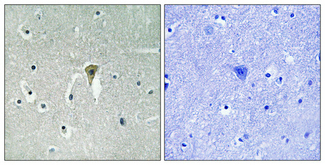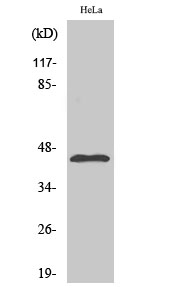Phospho Kir6.2 (T224) Cell-Based Colorimetric ELISA Kit
- 货号:KA1503C
- 应用:ELISA
- 种属:Human;Mouse
- 基因名称:
- KCNJ11
- Human Gene Id:
- 3767
- Human Swiss Prot No:
- Q14654
- Mouse Swiss Prot No:
- Q61743
- 储存:
- 2-8°C/6 months
- 其他名称:
- ATP-sensitive inward rectifier potassium channel 11 (IKATP) (Inward rectifier K(+) channel Kir6.2) (Potassium channel, inwardly rectifying subfamily J member 11)
- 检测方法:
- Colorimetric
- 背景:
- disease:Defects in KCNJ11 are a cause of permanent neonatal diabetes mellitus (PNDM) [MIM:606176]. PNDM is a rare form of diabetes characterized by insulin-requiring hyperglycemia that is diagnosed within the first months of life.,disease:Defects in KCNJ11 are the cause of familial hyperinsulinemic hypoglycemia type 2 (HHF2) [MIM:601820]; also known as persistent hyperinsulinemic hypoglycemia of infancy (PPHI) or hyperinsulinism. HHF2 is the most common cause of persistent hypoglycemia in infancy and is due to defective negative feedback regulation of insulin secretion by low glucose levels. It causes nesidioblastosis, a diffuse abnormality of the pancreas in which there is extensive, often disorganized formation of new islets. Unless early and aggressive intervention is undertaken, brain damage from recurrent episodes of hypoglycemia may occur.,disease:Defects in KCNJ11 are the cause of transient neonatal diabetes mellitus type 3 (TNDM3) [MIM:610582]. Neonatal diabetes mellitus, defined as insulin-requiring hyperglycemia within the first month of life, is a rare entity. In about half of the neonates, diabetes is transient and resolves at a median age of 3 months, whereas the rest have a permanent form of diabetes. In a significant number of patients with transient neonatal diabetes mellitus, diabetes type 2 appears later in life. The onset and severity of TNDM3 is variable with childhood-onset diabetes, gestational diabetes or adult-onset diabetes described.,disease:Defects in KCNJ11 may contribute to non-insulin-dependent diabetes mellitus (NIDDM), also known as diabetes mellitus type 2.,function:This receptor is controlled by G proteins. Inward rectifier potassium channels are characterized by a greater tendency to allow potassium to flow into the cell rather than out of it. Their voltage dependence is regulated by the concentration of extracellular potassium; as external potassium is raised, the voltage range of the channel opening shifts to more positive voltages. The inward rectification is mainly due to the blockage of outward current by internal magnesium. Can be blocked by extracellular barium.,similarity:Belongs to the inward rectifier-type potassium channel family.,subunit:Associates with ABCC8/SUR.,
- 功能:
- regulation of peptide secretion, negative regulation of peptide secretion, monosaccharide metabolic process, glucose metabolic process, ion transport, cation transport, potassium ion transport, cellular ion homeostasis, response to organic substance, potassium ion import, monovalent inorganic cation transport, hexose metabolic process, cellular homeostasis, metal ion transport, response to ATP, regulation of membrane potential, response to drug, homeostatic process, negative regulation of insulin secretion, regulation of hormone secretion, negative regulation of hormone secretion, chemical homeostasis, regulation of insulin secretion, ion homeostasis, neurological system process,regulation of secretion, negative regulation of secretion, negative regulation of transport, cellular chemical homeostasis, regulation of cellular localization,
- 细胞定位:
- Membrane; Multi-pass membrane protein.
- June 19-2018
- WESTERN IMMUNOBLOTTING PROTOCOL
- June 19-2018
- IMMUNOHISTOCHEMISTRY-PARAFFIN PROTOCOL
- June 19-2018
- IMMUNOFLUORESCENCE PROTOCOL
- September 08-2020
- FLOW-CYTOMEYRT-PROTOCOL
- May 20-2022
- Cell-Based ELISA│解您多样本WB检测之困扰
- July 13-2018
- CELL-BASED-ELISA-PROTOCOL-FOR-ACETYL-PROTEIN
- July 13-2018
- CELL-BASED-ELISA-PROTOCOL-FOR-PHOSPHO-PROTEIN
- July 13-2018
- Antibody-FAQs


